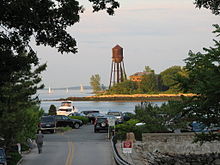Remote Patient Monitoring in New Rochelle

Reducing Hospital Readmission Rates in New Rochelle
Amelia Home Care addresses avoidable readmissions by blending live 24/7 Professional Remote Care Coordination (RCC) with the latest intuitive remote patient monitoring.
Our team provides timely interventions, bridges external care services, and addresses patient psychosocial needs. RCCs collect and share patient data with the healthcare team, a key pillar in preventing avoidable readmissions.
With thousands of patients, Amelia Home Care is seeing a reduction in readmission rates of 91 to 95 percent.
Remote Care Coordination in New Rochelle
Our Remote Care Coordinators (RCCs) provide face-to-face, video chat interactions with your patients to monitor and assist in adherence and reducing readmissions while improving clinical patient outcomes.
With the ability to visually record patient vitals, assess patient needs for medication refills, food, transportation to medical appointments, and social interactions, our coordinators develop personalized patient care with established protocols.
Available 24/7, RCCs cover the extended hours and weekends when staffing from Home Health is typically limited. Amelia Home Care patients thrive with more attention and interaction, and their satisfaction scores prove it!
Care Pathways for New Rochelle Clients
Amelia Home Care has over 95 Care Pathways currently available to our clients including combination pathways for patients with multiple co-morbidities.
These pathways include branch logic and RCC protocol for follow-up questions. Our RCCs are trained to identify and report issues with post-acute and post-surgical patients, including the identification of SIRS criteria, which may lead to sepsis.
In addition to pathways questions, vital signs, and video conferencing, we have educational videos, teach-back questions, reminders, and the ability to assist patients in obtaining appointments, video-conferencing with family members, and other members of the care team.


Psychosocial Needs and Socialization for New Rochelle Residents
Often, many of our patients are seniors between 70 to 95 years old, and many are lonely and isolated. The RCC’s responsibility is to engage in casual conversations, beyond the illness and discuss life, and joyful matters.
For patients who require more attention, often receive multiple video calls per day and are assigned to volunteers to check in with the patients.
The results are astonishing, leading to reduction of readmissions, happier patient satisfaction, and increased RPM utilization rate.
Amelia Home Care Health Platform
Based on the patient’s capability and comfort level utilizing their preferred communication device, Amelia Home Care provides a variety of platforms to ensure as many patients are enrolled in the program as possible.
For patients accustomed to utilizing their own personal smartphone or tablet (Apple or Android), an easy-to-download application is provided.
A telehealth kit, which consists of a tablet with built-in internet and wireless medical devices and is intuitive to operate, can be delivered to the patient’s home.
If both are not viable options, their assigned RCC can render phone calls to retrieve ongoing data collection so no patient is left out of the program.
Authorized physicians, nurses, nursing staff, and Home Health agencies will have access to patient data and telehealth communication with the patient based on their security access privileges.
Oftentimes, physicians and nurses find it more convenient to work with the assigned RCC.
Based on schedule or ad hoc calls, the RCC can engage the physician on a group video conference with the patient by sending a link to the physician’s email or phone.
Upon clicking the link, the physician will be able to join the secured video conference call with the patient.
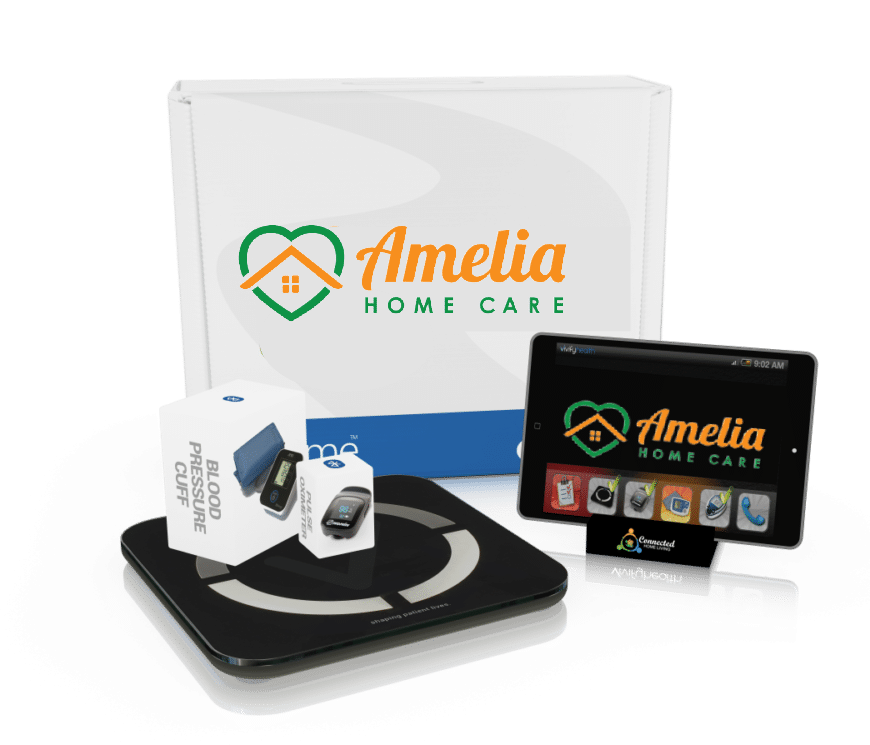

How We Help Hospitals and Health Systems in New Rochelle
TURN-KEY communication center for efficient coordination of care – no implementation or set up fee.
FACILITATE safe return to home – enabling shorter hospital length of stay.
REDUCE unnecessary hospital readmissions.
ENABLE the efficient and streamlined monitoring of post-acute care.
MANAGE the volume of incoming data based upon clinically defined thresholds.
COLLECT clinically meaningful data to enhance and adjust care.
SUPPORT client/patient autonomy through education and communication.
ENHANCE resource management to ensure clinical visits are necessary, with documented justification.
DRIVE value-based care by increasing and enhancing ongoing interactions between patients and clinicians.
DEFINE the standard of care in the marketplace.
How We Help Physician Groups in New Rochelle
TURN-KEY remote monitoring communication center for efficient coordination of care.
FACILITATES ease of access to patient data.
MANAGES the volume of incoming data based upon clinically defined thresholds.
COLLECT clinically meaningful data to enhance and adjust care.
SUPPORT the delivery of higher quality care to more patients.
REDUCE unnecessary hospital readmissions.
ENABLE the efficient and streamlined monitoring of post-acute care.
SUPPORT client/patient autonomy through education and communication.
ENHANCE resource management to ensure clinical visits are necessary, with documented justification.
POSITION practice for the value-based care market by increasing ongoing interactions between patients and clinicians.
DEFINE the standard of care in the marketplace.
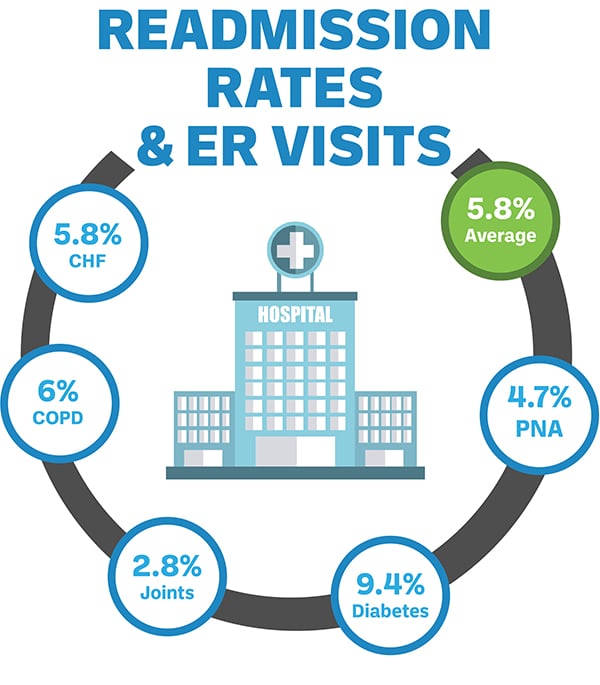

How We Help Accountable Care Organizations Who Serve New Rochelle
- CHRONIC CARE management supporting a reduction in Medicare costs.
- IMPROVED communication channels between multiple providers and specialists.
- ENABLE enhanced care coordination throughout the medical care continuum.
- REDUCE unnecessary and redundant healthcare service.
- FACILITATE your ability to meet CMS standards for cost savings.
- COLLECT clinically meaningful data to enhance and adjust care.
- SUPPORT client/patient autonomy through education and communication.
- ENHANCE resource management to ensure clinical visits are necessary, with documented justification.
- DRIVE value-based care by increasing and enhancing ongoing interactions between patients and clinicians.
- ENGAGE patients in their care and drive patient centricity.
Programs and Plans

Amelia's Tele-Home Care Family Pack for New Rochelle Residents
How Does Virtual Caregiving Work?
- Sign-up loved ones based on their needs and technological ability using a smartphone, tablet, computer or landline
- Amelia Home Care develops a care plan and trains your loved ones to use our telehealth solution
- Daily Health Surveys monitor your health
- Live Remote Care Coordinators (RCCs) evaluate your needs and provide support
- RCCs escalate issues to a Family Member or Nurse, based on pre-defined protocols
- Nurse or Physicians may assess and treat patient using video triage*
- RCC can coordinate medication, food, and supplies
Are you ready for an Amelia Home Care Certified Technologist to install and train your family to be connected and safe. With Amelia’s Tele-Home Care Family Pack, Seniors can live independently longer, safe from falls and other common concerns.
There’s an emergency button to request help at anytime, and also activity sensors that will detect hazards and call for help when it’s need.
Seniors can live independent longer, safe from falls and other common concerns, with Amelia’s Tele-Home Care Family Pack.
There’s an emergency button to request help at anytime, and also activity sensors that will detect hazards and call for help when it’s need.
Best of all, caregivers can check in anytime – without disturbing the senior or invading their privacy.
How Does Amelia’s Tele-Home Care Family PackWork?
Amelia Home Care is a Certified Technologist that Installs and Trains for You!
Install The Family Pack.
A personal assist button, front and back door entry sensors, and motion sensors for the Kitchen, Hallway, and Living Room are easy to install. It includes everything you need to address concerns of falls, wellness, and loneliness in a new collaborative way. Installation is fast and simple.
The activities of daily living are learned.
The normal lifestyle patterns of the senior are privately learned, without a wearable, and insights can be accessed by members of your Trusted Circle of friends and family.
Smart Home Center
This makes your home intelligent. Simply plug it in to power and plug in a wired internet connection. The free app will walk you through the whole process.
Personal Assist Button
Push it at any time to alert the people in your Trusted Circle and let them know that assistance is needed. Or change its behavior to record access to medication.
Front Door and Back Door Entry Sensors
They attach to a home’s high-traffic doors in just minutes so you can know when someone comes and goes. Install extras on medicine cabinets, refrigerators, and microwaves.
Kitchen, Hallway, and Living Room Motion Sensors
They alert for potential falls, sleep problems, and more. We recommend one motion sensor every 500 square feet of living space, so the base pack covers about 1,500 square feet.
Professional Monitoring. 24/7.
When lifestyle patterns change unexpectedly, automatically alert your Trusted Circle and the Emergency Call Center to get help fast.
The Amelia Home Care Trusted Circle
This intelligent system uses easy to install wireless sensors around the home (no cameras) to learn daily activity patterns and alerts family, professional caregivers, and emergency services (if necessary) of falls and potential hazards even if the emergency button is out of reach.
The Trusted Circle is an exclusive group of contacts who care for the wellbeing of a friend or loved one using Amelia Home Care Family in their home.
Trusted Circle contacts receive Group SMS Notifications and In-App Push Notifications to actively participate and immediately respond to falls and other potential hazards or simply stay in the know. Contacts can also use the Amelia Home Care Family app to get real-time wellness status updates, daily reports, and more.
Join the Trusted Circle
- You will receive a text message invitation from Amelia Home Care.
- Click on the provided link, download the Amelia Home Care app, and follow the instructions to setup your Amelia Home Care account.
- Add the Amelia Care Family Emergency Call Center phone number to your contact list for safekeeping. Unknown numbers are often considered SPAM so it’s best to be ready to help when called upon


How it Works
This intelligent system uses easy to install wireless sensors around the home (no cameras) to learn daily activity patterns and alerts family, professional caregivers, and emergency services (if necessary) of falls and potential hazards even if the emergency button is out of reach.

Know that everything is okay. Get real-time wellness status updates, daily reports, and more.
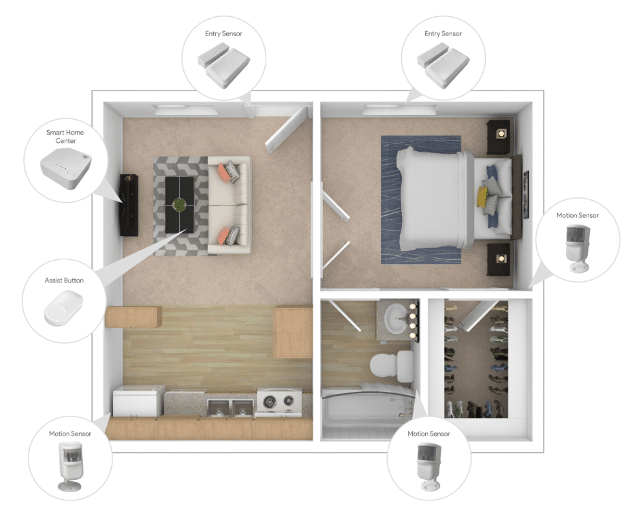
Monitors the home 24/7 including fall detection, failure to return, sleep monitoring, and more.
When problems arise, Amelia Home Care Family communicates outward in a tiered escalation methodology as urgency increases. This approach gives family and professional caregivers an opportunity to get involved and deescalate issues before dispatching Emergency Services.

Get alerted and know what’s happening.
Get involved right away to help resolve the issue.
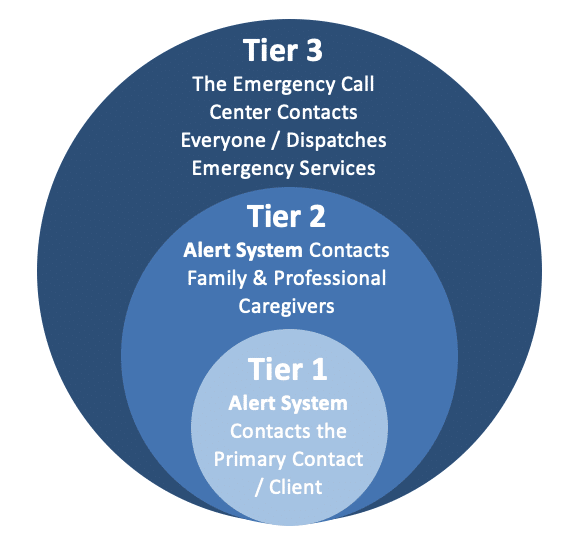
Group SMS Notifications, In-App Push Notifications,
24/7 Call Center, & Emergency Services
Features for Every Lifestyle
Captures and describes lifestyle patterns into the app
- Check-in remotely, review the Daily Report, and know where people were last seen.
- Detects when people are home, away, or sleeping.
- Record access to medication with a variety of medication activity sensors.
Measures sleep quality with an activity sensor in the bedroom. - Track trips to the bathroom, showers, and bathroom falls with a bathroom motion sensor.
- Identifies meal activities with access to the microwave, coffee, and fridge.
Alerts when problems are detected
- Fall detection without a button: alerts on unexpected inactivity in the home.
- Medical alert button to call for emergency help or simply request assistance.
- Alert if occupants do not get up in the morning.
- Notify if occupants did not make it to the bedroom at night.
- Detect if the stove is left on, unattended.
- Delivers reminders if people forgot to take medication.
- Mold and mildew detection with added humidity sensors.
- Integrates fall and SOS alerts from Apple Watch and Samsung Galaxy Watch.
- Uses text messages for alerts, so family participants don’t have to download an app.
Proven to help fight senior depression, loneliness, and isolation
- Coordinates and assigns a new family member to reach out each day, with suggestions on what to talk about from the last person.
- Smart Speaker support to control the home, play music, and connect family.
Adds needed support for Dementia and Alzheimer’s
- Alerts when perimeter doors open to detect wandering.
- Predicts when occupants should arrive back home, and alerts if they’re not.
- Pings your phone if someone is caught roaming around the house at night.
- Water leak detection for the bathroom and toilet.
Expandable
- Apple Watch and Samsung Galaxy Watch keep track of falls.
- Amazon Alexa and Google Home integrate to control with your voice.
- Smart Locks secure the home and provide access to the Trusted Circle.
- Smart Bulbs and Plugs to control lighting and appliances with your voice.
- Connected Thermostats integrate to control comfort and save energy.
- Security system enabled with a siren and keypad helps seniors feel in control.
About New Rochelle
New Rochelle is a city in Westchester County, New York, United States, in the southeastern portion of the state. In 2010, the city had a population of 77,062, making it the seventh-largest in the state of New York. Wikipedia
Historic sites
- Columbia Island – a small island (approx. 150 feet (46 m) square) situated between Davids’ Island and Pea Island. Up until 1940 it was known as Little Pea Island. CBS purchased it and built a concrete foundation to support a transmitter building topped by a 410-foot (120 m) tall antenna tower for WCBS-AM.[22][23] The transmitter remained in operation until the 1960s, when the station was moved to nearby High Island.
- Execution Rocks Lighthouse – centered in the middle of Long Island Sound, just south of Davids’ Island. The structure was built in 1849 and includes a 55-foot (17 m) tall tower and the ‘keeper’s house’. It is rumored that the lighthouse’s site got its name before the American Revolutionary War when British colonial authorities executed people by chaining them to the rocks at low tide and allowing the rising water to drown them. In reality, the name was chosen to reflect the historically dangerous shipping area created by the rocks exposure during low tides.
- Huckleberry Island – a 10-acre (40,000 m2) island owned by the Huckleberry Indians, Inc., a club within the New York Athletic Club. The island is an important nesting site for waterbirds such as egrets and night herons.
- Leland Castle – a 19th-century Gothic Revival castle built as the summer residence of Simeon Leland, a wealthy New York City hotel entrepreneur. It has since been acquired by the College of New Rochelle and is used as an art gallery available to the public.
- St. John’s Wilmot Church – a historic Episcopal parish located in the northern end of the City at the intersection of North Avenue and Wilmot Road, formerly referred to as “Cooper’s Corner“.
- Thomas Paine Historical Site – a historical nexus within the city, the site comprises: the country home of the American pamphleteer and Revolutionary War hero Thomas Paine, his burial site, monument, and a museum. Paine’s Cottage was built in 1793 and is a National Historic Landmark. The Thomas Paine Memorial Building, built in 1925, houses the library and museum collection of the Thomas Paine National Historical Association. Also on the site is the Brewster Schoolhouse, one of the oldest structural relics in Westchester County.
- Trinity-St. Paul’s Episcopal Church – added to the National Register of Historic Places in 2006. It is located at the northwest corner of Huguenot Street (also known as the Boston Post Road) and Division Street. This church represents the body of the majority group of New Rochelle’s founding Huguenot French Calvinistic congregation that conformed to the liturgy of the established Church of England in June 1709. King George III gave Trinity its first charter in 1762. After the Revolutionary War, Trinity became a parish of the Protestant Episcopal Church of America
Parks
The City has a collection of parklands and nature preserves, with 102.5 acres (0.415 km2) of inland waters, 231.51 acres (0.9369 km2) of public park lands and 168 acres (0.68 km2) of park lets.
- Glen Island – In 1879, John H. Starin, a former US Congressman and New York transportation king, bought five islands which he named ‘Glen Island’ and created perhaps the first theme park open to the public. His 12 steamboats transported millions of New York residents and others to the attractions which included a zoo, a natural history museum, a railway, a German beer garden (around the castle-like structure which still stands today), a bathing beach, and a Chinese pagoda. Today the park is a 105-acre (0.42 km2) island property connected to the mainland by a drawbridge built in the 1920s. One of the main features of the park is its pristine, crescent shaped beach offering access to Long Island Sound.
- Five Islands Park is a series of islands connected by small footbridges and pathways, offers playground, sports, hiking and camping facilities for all residents to enjoy.
- Hudson Park encompasses 13 acres (0.053 km2) along the city’s harbor front and includes a beach for residents, the city boathouse, greenhouses, the shore station of the United States Coast Guard and several yacht and rowing clubs. The park is traditionally accepted as the original landing place of the Huguenot settlers. A granite boulder with bronze tablets commemorates the event.
- Davids’ Island, a 78-acre (320,000 m2) island of the coast of the city, is being transformed from a former American military base (Fort Slocum) into a park and environmental preserve. Beginning just after the Civil War, the island was a military base used to protect New York Harbors, during World War I it served as an army recruitment station and up until 1967, it maintained various ‘Cold War’ facilities. Today it is home to a variety of plants, birds, and animals. These include the endangered Kemp’s ridley sea turtle, and rare birds such as osprey and least terns. Davids Island also supports valuable wetlands, rare rocky intertidal areas, and sandy beaches. The waters surrounding the Island are home to Winter Flounder, Atlantic Herring, and Atlantic Silversides.
- Ward Acres, located in the North End, is a combination of untouched forest, wild lawns and meadows, acres of hiking, exercise trails and historic horse stables/cemeteries. In 2007, The Westchester County Department of Conservation produced a Natural Resource Management Plan in order to identify and protect the natural resource needs of the park. It encompasses 62 acres (250,000 m2), with the forests divided into four main sections, each distinct in both general characteristics and species presence. It is formed by a portion of a former private state that contained a horse farm, and by an old railroad right of way. It includes a 3-acre (12,000 m2) fenced-in dog run, and it is the only park in the City in which residents can walk a dog without a leash.[30]
- The Leatherstocking Trail is a 2-mile (3.2 km) long, inter-municipal hiking trail situated between New Rochelle and Mamaroneck, eventually linking into Saxon Woods County Park. It is part of a larger “Colonial Greenway Trail” in which it connects to Twin Lakes/Nature Study and Saxon Woods parks.[31]
- Sheldrake Lake which formerly served as a reservoir supplying the areas drinking water, is now a 60 acres (0.24 km2) park and nature conservancy promoting an increased understanding of the local ecology.
- Twin Lakes Park, combined with the adjacent Nature Study Woods comprise 220 acres (0.89 km2) of woods, marsh, lakes, ponds and some fields along the Hutchinson River in New Rochelle’s Northend. There are many foot trails weaving through woods, marshlands, fields and around two large lakes (formerly reservoirs).[32]
19th and 20th centuries
Through the 18th century, New Rochelle had remained a modest village that retained an abundance of agricultural land. During the 19th century, however, New York City was a destination from the mid-century on by waves of immigration, principally from Ireland and Germany. More established American families left New York City and moved into this area. Although the original Huguenot population was rapidly shrinking in relative size, through ownership of land, businesses, banks, and small manufactures, they retained a predominant hold on the political and social life of the town.
The 1820 Census showed 150 African-Americans residing in New Rochelle, six of whom were still slaves. The state abolished slavery by degrees: children of slave mothers were born free, and all slaves were freed by 1827.
In 1857 the Village of New Rochelle was established within the borders of the Town of New Rochelle. A group of volunteers created the first fire service in 1861. In 1899, a bill creating the New Rochelle City Charter was signed by Governor Theodore Roosevelt. It was through this bill that the Village and Town of New Rochelle were joined into one municipality. In 1899, Michael J. Dillon narrowly defeated Hugh A. Harmer to become New Rochelle’s first mayor. The recently established city charter designated a board of aldermen as the legislative unit with two members to be elected from each of four wards and 10 elected from the city at-large.[10]
By 1900, New Rochelle had a population of 14,720. Throughout the city, farms, estates, and wooded homesteads were bought up by realty and development companies.[11] Planned residential neighborhoods such as Rochelle Park, one of the first planned communities in the country, soon spread across the city, earning New Rochelle the sobriquet “City of Homes”.[12] In 1909, Edwin Thanhouser established Thanhouser Film Corporation. Thanhouser’s Million Dollar Mystery was one of the first serial motion pictures.[13] In 1923, New Rochelle resident Anna Jones became the first African-American woman to be admitted to the New York State Bar.[14]
Poet and resident James J. Montague captured the image of New Rochelle at the time in his 1926 poem “Queen City of the Sound”.[15]
In 1930, New Rochelle recorded a population of 54,000, up from 36,213 only ten years earlier. During the 1930s, New Rochelle was the wealthiest city per capita in New York state and the third wealthiest in the country.[16]
By the end of the century, the Metro North railroad station was rebuilt along with a $190 million entertainment complex, nicknamed New Roc City, which features a 19-screen movie theater, an IMAX theater, an indoor ice-hockey arena, mini-golf, go karts, an arcade, restaurants, a hotel, loft-apartments and a mega supermarket. The complex was built on the site of the former New Rochelle Mall, which had opened in 1968.[17]
Office for the Aging
Function
The New Rochelle Office for the Aging offers free, comprehensive services for New Rochelle seniors and their families.
Appointments
Trained professionals are available for scheduled appointments during office hours. Walk-ins are accepted and welcomed.
News Events
Click on the title to see the coverage from past events.
Thanksgiving Luncheon
Festa Italiana
Assistance is available in the areas of:
- Health
- Housing
- Income maintenance
- Local Transportation
- Nutrition
- Recreational information
- Referrals

Map of New Rochelle
Map of Directions from New Rochelle to Amelia Home Care
Driving Direction from New Rochelle to Amelia Home Care
New Rochelle, New York
Get on I-95 S from Garden St
3 min (0.9 mi)
Head northwest on North Ave toward Huguenot St
0.1 mi
Turn right onto Garden St
0.3 mi
Continue onto Cedar St
0.1 mi
Use the right lane to take the ramp onto I-95 S
0.4 mi
Continue on I-95 S. Take Cross Island Pkwy and Belt Pkwy to Shore Pkwy in Brooklyn, New York. Take exit 7B from Belt Pkwy
46 min (37.0 mi)
Merge onto I-95 S
7.0 mi
Keep left at the fork to continue on I-695 S, follow signs for Interstate 695 S/Interstate 295 S/Throgs Neck Br/Long Island
1.4 mi
Merge onto I-295 S
Toll road
2.6 mi
Take exit 8 to merge onto Cross Island Pkwy
9.0 mi
Use the right 2 lanes to take the Belt Pkwy exit toward Kennedy Airport/Brooklyn
0.3 mi
Continue onto Belt Pkwy/Laurelton Pkwy
1.3 mi
Keep left to continue on Belt Pkwy
15.2 mi
Take exit 7B toward Ocean Pkwy
0.1 mi
Continue on Shore Pkwy. Take Ocean Pkwy to Ocean Parkway Service Rd
8 min (1.2 mi)
Continue onto Shore Pkwy
0.2 mi
Turn left onto Ocean Pkwy
0.4 mi
Turn left onto Ocean View Ave
0.1 mi
Turn right onto Brighton 2nd St
0.1 mi
Turn right onto Brighton Beach Ave
0.2 mi
Turn right onto Ocean Parkway Serv
Amelia Homecare, Inc
3007 Ocean Pkwy 1ST FLOOR, Brooklyn, NY 11235
